Exploring Rome on a budget doesn’t mean you must miss out on its splendors, especially when it comes to free things to do in Rome.
Admiring the greatness of St Peter’s Basilica is completely free, making it a must-see for any traveler. This largest and most spectacular church in Rome provides a breathtaking glimpse into the city’s rich history and architecture.
Wandering the streets of the Eternal City lets you uncover hidden gems like ancient ruins and beautiful fountains. You can visit popular spots like the Spanish Steps and Trevi Fountain without spending a dime. Walking through areas such as Trastevere provides a taste of the local culture and vibrant neighborhood life.
Nature lovers can head to Villa Borghese, one of Rome’s largest parks, where they can enjoy peaceful strolls, picnics, and even a free view of the city from Pincian Hill.
Art enthusiasts may appreciate the free admission days at various museums, which allow them to soak up Rome’s culture without breaking the bank. With so many free things to do in Rome, your adventure in this captivating city will be truly unforgettable!
Free Things to Do in Rome: Historic Squares and Fountains
Rome is home to many historic squares and stunning fountains that are free to visit. Each offers a unique glimpse into the city’s rich history and culture.
Explore the Piazza Navona
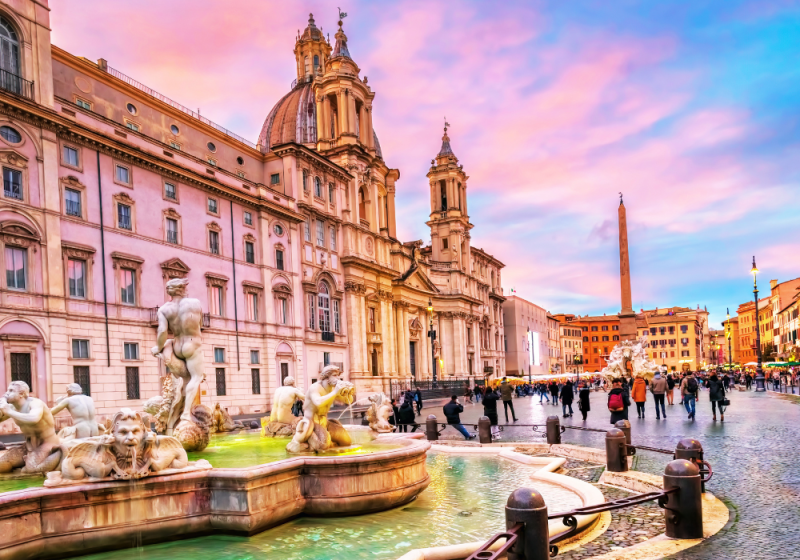
Piazza Navona is a beautiful square known for its Baroque architecture. In the center, you can see the amazing Fontana dei Quattro Fiumi, or Fountain of the Four Rivers.
Bernini designed this fountain to represent four major rivers from different continents: the Nile, the Ganges, the Danube, and the Rio de la Plata.
Around the square, you’ll find street artists, cozy cafés, and charming shops. The church of Sant’Agnese in Agone is also here, showcasing stunning architecture and artwork.
Piazza Navona was originally built on the site of the Stadium of Domitian, which gives it its unique long, oval shape.
Make a Wish at the Trevi Fountain
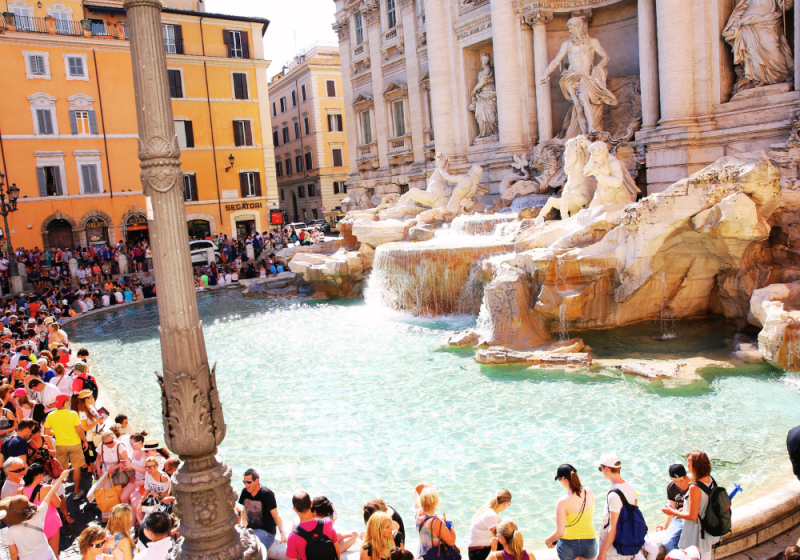
The Trevi Fountain is one of Rome’s most iconic landmarks. Designed by Nicola Salvi and completed in 1762, it stands 26 meters tall and 49 meters wide. The fountain is decorated with statues representing the sea god Oceanus, tritons, seahorses, and other sea creatures.
Tradition says that if you throw a coin into the fountain with your right hand over your left shoulder, you will return to Rome.
This ritual makes the Trevi Fountain not only a beautiful sight but also an interactive experience. The fountain is especially lovely at night when it’s illuminated.
Climb the Spanish Steps
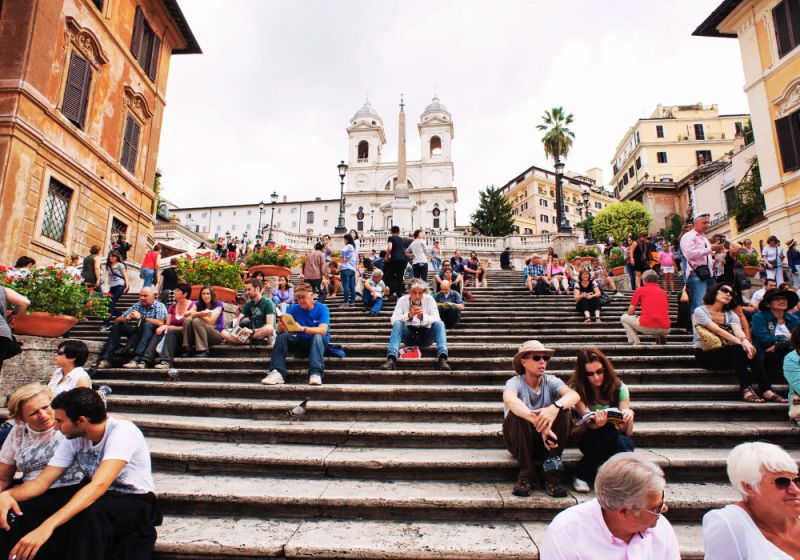
The Spanish Steps, built in the early 18th century, link Piazza di Spagna with the Trinità dei Monti church at the top. They have 135 steps and are a popular spot for locals and tourists to sit and enjoy the view.
The Barcaccia Fountain, designed by Bernini, is at the base of the steps. Nearby, the Keats-Shelley Memorial House honors the romantic poets. The luxury shopping street Via Condotti is also nearby, perfect for a stroll after your climb.
Relax at Piazza del Popolo
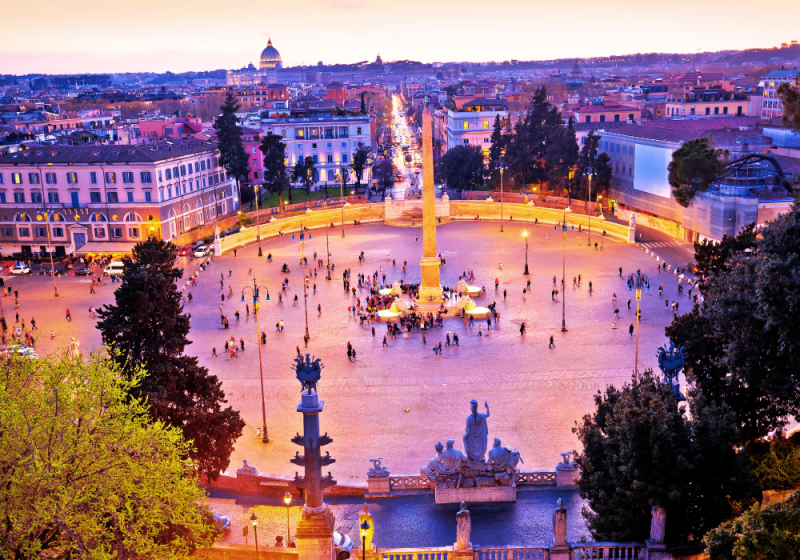
Piazza del Popolo is a large square at Rome’s northern gate. Its center features an Egyptian obelisk brought to Rome during Augustus’s reign. The twin churches, Santa Maria dei Miracoli and Santa Maria in Montesanto, stand on either side of the square.
Climb the steps to Pincio Hill for a panoramic view of the city. The square often hosts events and exhibitions, making it a lively place to visit. The nearby Via del Corso is a bustling shopping street with many popular stores.
Browse the Campo de’ Fiori Market
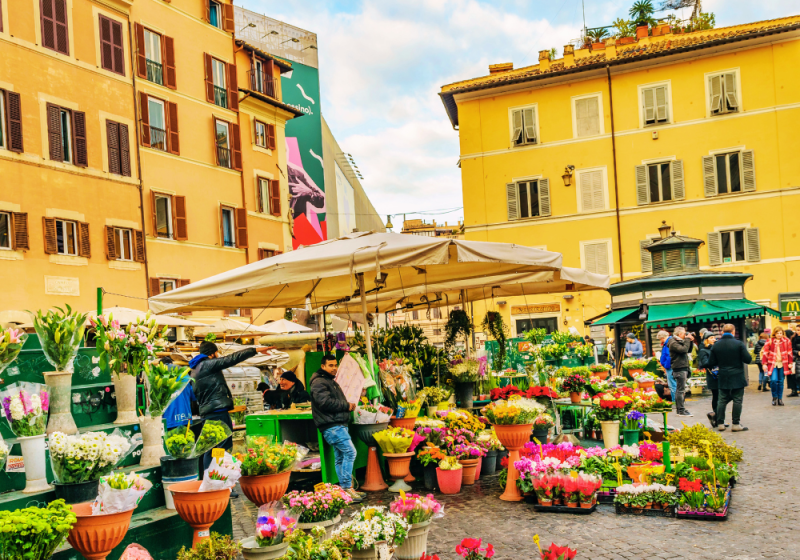
Campo de’ Fiori is a vibrant market square known for its daily flower, fruit, and vegetable market. It has a lively atmosphere, especially in the mornings. In the center of the square, you’ll find a statue of Giordano Bruno, who was executed here in 1600.
In the evening, the square transforms into outdoor cafés and restaurants, perfect for a casual dinner or drink.
Many visitors enjoy the fresh produce, local specialties, and the bustling environment of Campo de’ Fiori. The surrounding streets are also filled with artisanal shops and boutique stores.
Iconic Roman Landmarks
Rome is bursting with historical landmarks that can be seen for free.
This section covers three of the most iconic ones: the Pantheon, the Roman Forum, and the exterior of the Colosseum. Each offers a unique glimpse into the city’s rich history.
Marvel at the Pantheon
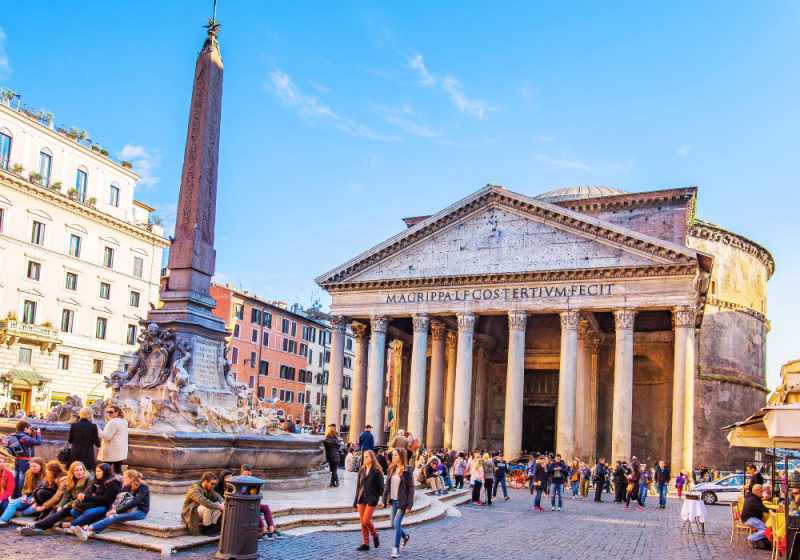
The Pantheon, originally a temple for all Roman gods, is an architectural marvel. Constructed around 126 AD during Emperor Hadrian’s reign, it is remarkably well-preserved.
The Pantheon’s massive dome is its most striking feature. It remains the largest unsupported concrete dome in the world. The oculus, a 27-foot hole at the dome’s center, allows natural light to flood the interior, creating a dramatic effect.
Inside, you’ll find the tombs of several important figures, including the artist Raphael. The marble floors and Corinthian columns add to the Pantheon’s grandeur.
Located in Piazza della Rotonda, the Pantheon is easily accessible and free to enter, making it a must-visit when exploring Rome.
Discover the Roman Forum
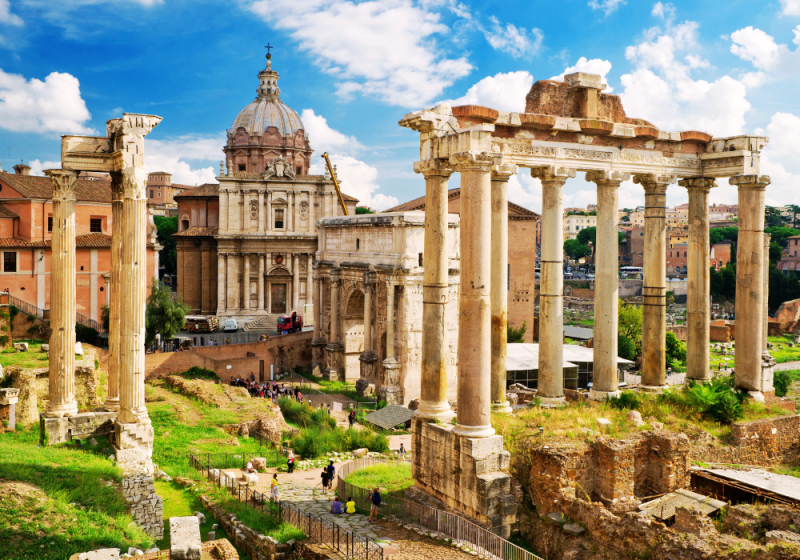
The Roman Forum, once the heart of ancient Rome, is a sprawling area filled with ruins of temples, basilicas, and public spaces. It was the city’s political, commercial, and social center for centuries.
You can stroll through the open grounds and see significant structures like the Temple of Saturn, the Arch of Titus, and the House of the Vestal Virgins. Each ruin tells a story of Rome’s powerful past.
The forum’s location between the Palatine and Capitoline Hills provides stunning views of the surrounding area. Aim to visit in the early morning or late afternoon to avoid the crowds and enjoy the peaceful atmosphere.
Although it is part of the Colosseum complex, walking around the Forum itself doesn’t cost money. It’s an insightful way to connect with Rome’s ancient history.
Visit the Colosseum’s Exterior
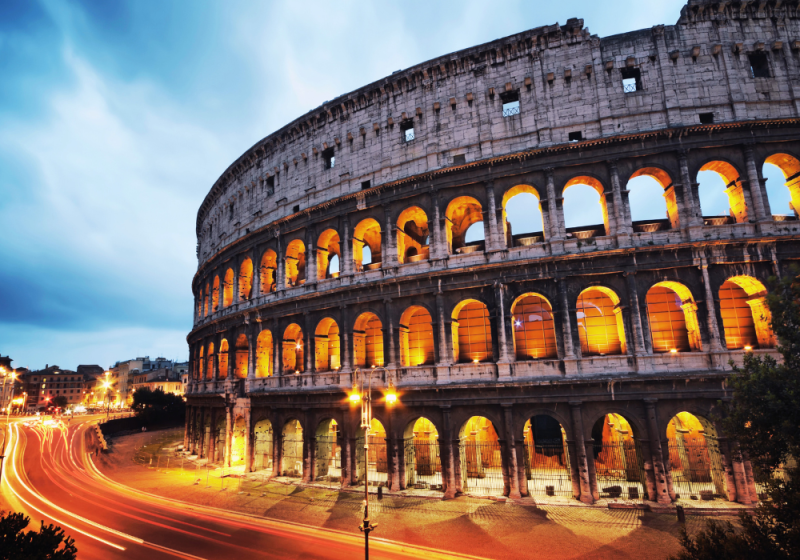
The Colosseum is perhaps Rome’s most iconic landmark. Completed in 80 AD, this ancient arena could hold up to 80,000 spectators, who gathered to watch gladiatorial games and other public spectacles. Outside, you can admire the Colosseum’s immense scale and intricate architecture. The exterior is adorned with arches and columns that showcase Roman engineering prowess.
Three main stories are visible, each with a distinct style of columns: Doric, Ionic, and Corinthian. The arches are a popular photo spot and give a sense of the building’s grandeur.
While touring the interior requires a ticket, soaking in the Colosseum’s exterior is free. Its central location makes it easy to include in your walking tour of Rome’s historic sites.
Religious Sites and Artworks
Rome is home to some incredible religious sites and artworks. You can visit grand churches, see Michelangelo’s masterpieces, and admire beautiful sculptures.
Enter St. Peter’s Basilica
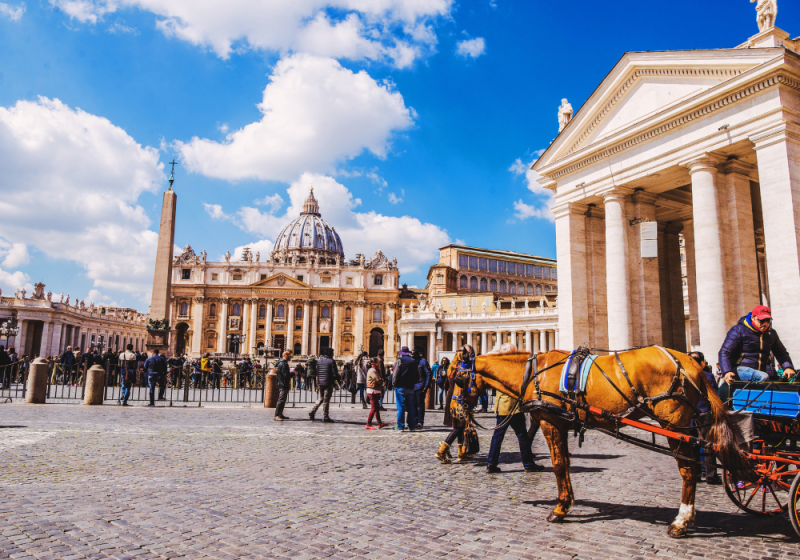
St. Peter’s Basilica is a must-see landmark in the Vatican. Built over several centuries, it is one of the largest churches in the world. The basilica’s entrance is free, and you can marvel at its Renaissance architecture.
The church holds several significant artworks, including Bernini’s Baldachin and the tomb of St. Peter. Michelangelo designed the dome, which offers panoramic views of Rome. Early mornings and late afternoons are the best times to visit to avoid crowds.
Admire Michelangelo’s Moses
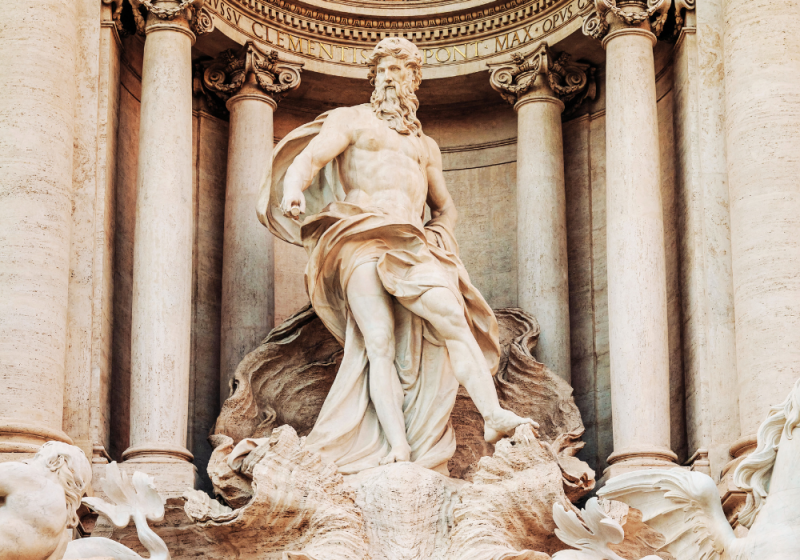
Michelangelo’s Moses is a famed Basilica di San Pietro statue in Vincoli. It was originally designed as a part of Pope Julius II’s tomb. The sculpture is known for its intricate details and powerful expression.
Look for Moses’ horned head, a unique feature from a mistranslation of the Bible. The basilica also has stunning frescoes and mosaics. Entry is free, making it an accessible destination for art lovers.
Observe Art at San Pietro in Vincoli
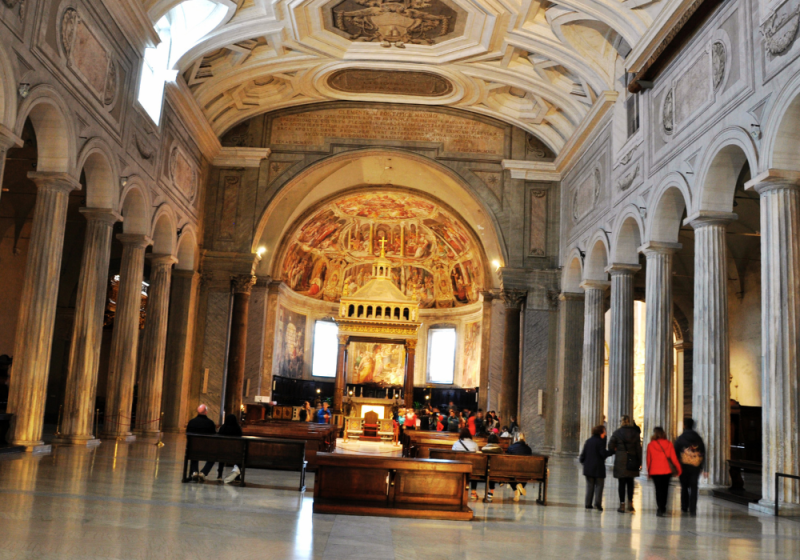
San Pietro in Vincoli houses even more notable artworks than Michelangelo’s Moses. The church is known for its beautiful ceiling and altar pieces. It was originally built to house the chains that bound Saint Peter when he was imprisoned in Jerusalem.
These chains are displayed in a glass case below the main altar. The basilica’s peaceful ambiance makes it a perfect spot for quiet reflection. As with other sites, entrance is free, so you can soak in the history and art without spending a dime.
Parks and Gardens
Rome offers a variety of beautiful parks and gardens to explore. These spaces offer a peaceful break from the bustling city streets, stunning views, and unique experiences.
Stroll Through Villa Borghese
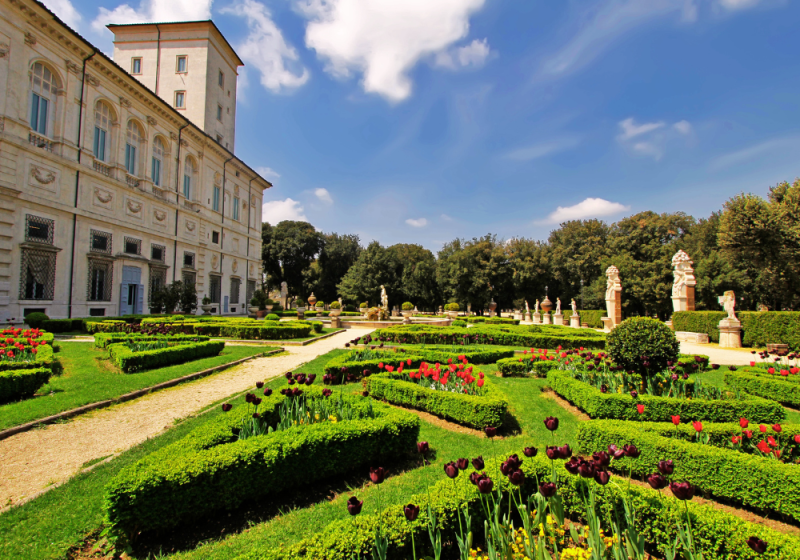
Villa Borghese is one of Rome’s largest and most famous parks. It’s known for its beautiful gardens, wide paths, and cultural attractions. As you wander, you’ll come across the Borghese Gallery, which houses an impressive art collection. The park also has charming lakes, sculptures, and fountains.
Bike rentals are available if you prefer to explore on wheels. There’s also a zoo, perfect for visitors with children. Picnicking by the lake is another popular activity. You might also catch a puppet show at the park’s puppet theatre.
Gaze from Gianicolo Hill
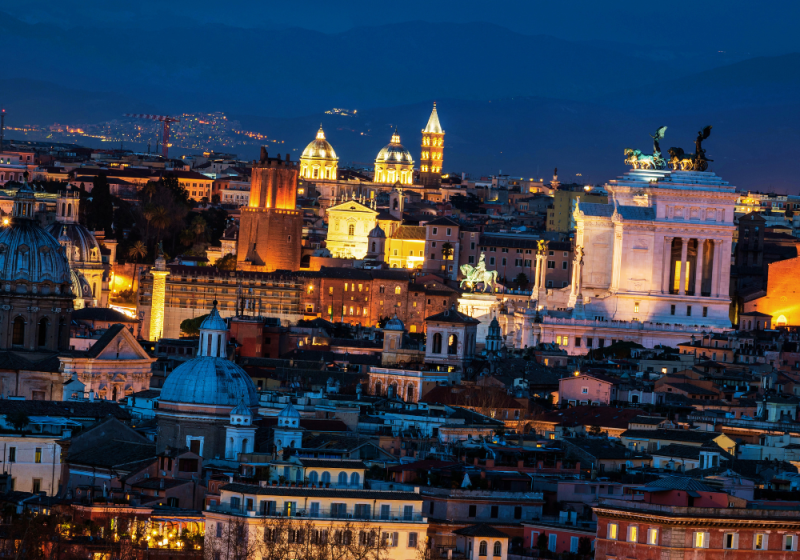
Gianicolo Hill, also known as Janiculum Hill, offers one of the best views of Rome. It’s a bit of a climb, but the reward is a panoramic scene of the city’s rooftops, domes, and towers. The hill is rich in history, featuring statues and monuments dedicated to Italy’s unification.
At noon, you can witness the daily cannon fire ceremony, a tradition since 1847. The area also includes a picturesque walk through shaded paths and lovely gardens. Don’t miss the interesting water fountain, Fontana dell’Acqua Paola, which adds to the hill’s charm.
Unwind in Villa Doria Pamphilj
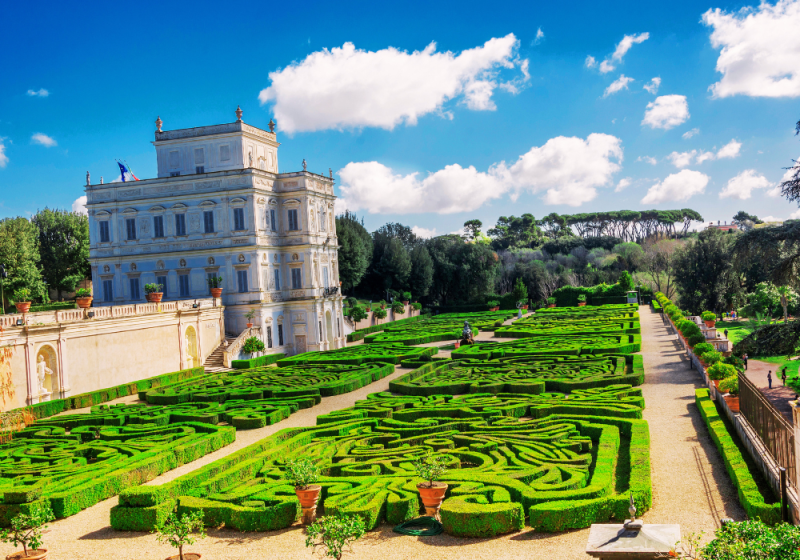
Villa Doria Pamphilj is Rome’s largest public park and a great place for some relaxation. The park features vast lawns, wooded areas, and well-kept gardens. Joggers and cyclists enjoy its long, scenic paths.
The villa inside the park, Casino del Bel Respiro, showcases stunning architecture and historical significance.
The park includes quiet spots ideal for picnicking or reading a book. Small lakes and numerous statues and fountains are scattered throughout. If you enjoy birdwatching, this park is home to various bird species that you might spot during your visit.
Charming Neighborhoods
Rome offers more than just iconic landmarks; its neighborhoods are filled with charm and history. Exploring these areas provides a deeper connection to the city’s culture and everyday life.
Wander Through Trastevere
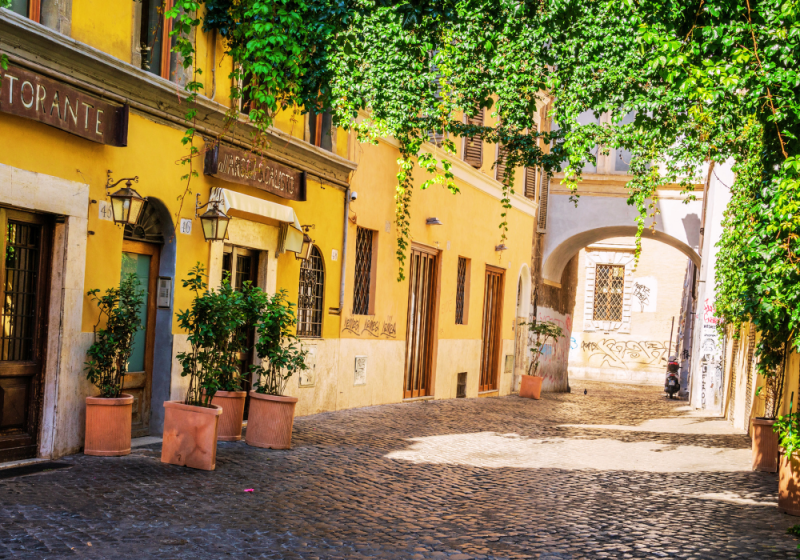
Trastevere, located across the Tiber River, is one of Rome’s most charming neighborhoods. Its narrow cobblestone streets and ivy-clad buildings invite you to enjoy strolls. Street performers and vibrant nightlife add to the lively atmosphere.
Visit the Basilica of Santa Maria, known for its stunning mosaics. Stop by tiny shops and artisanal boutiques for unique souvenirs. Trastevere’s lively piazzas, such as Piazza Santa Maria, are perfect for people-watching. Don’t miss the chance to taste traditional Roman dishes at local trattorias.
Experience the Jewish Ghetto
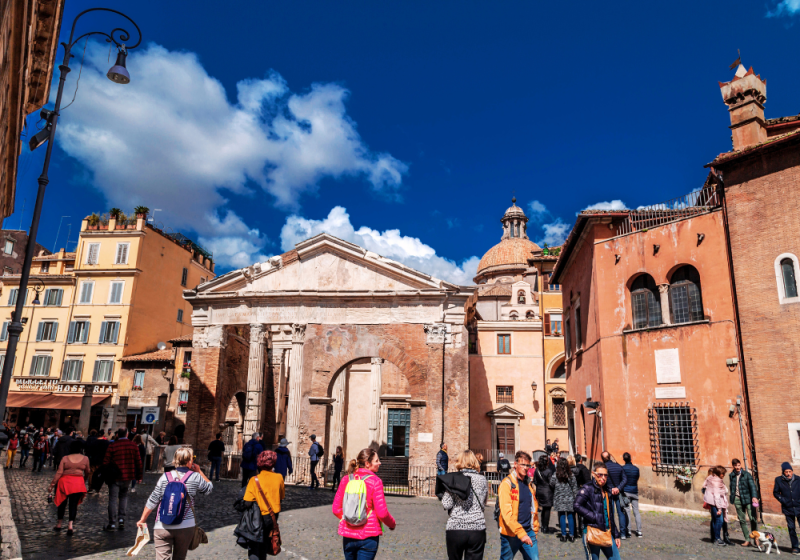
The Jewish Ghetto is another fascinating area to visit. Established in 1555, it is one of the oldest Jewish communities in Europe. The historic Synagogue of Rome’s unique square dome is a must-see.
Stroll through Via della Reginella and discover kosher bakeries and restaurants offering traditional Jewish-Roman cuisine. Try the carciofi alla giudia (fried artichokes), a local favorite. The Portico d’Ottavia, an ancient Roman ruin, also stands in this neighborhood.
Admire Quartiere Coppedè’s Architecture
Quartiere Coppedè is like stepping into a fairy tale. Designed by architect Gino Coppedè, this area features an eclectic mix of Art Nouveau, Baroque, and Medieval styles. The fantastical buildings capture your imagination with their intricate details.
Look for the Fountain of the Frogs in Piazza Mincio. Nearby, ornate facades and whimsical sculptures decorate the buildings. Each structure in Quartiere Coppedè tells a story, making it a captivating spot for architecture enthusiasts.
Cultural and Free Museums
Explore Rome’s rich cultural scene, especially through its many free museums. You can uncover historical art, religious artifacts, and ancient relics without spending a dime.
Investigate the Capitoline Museums
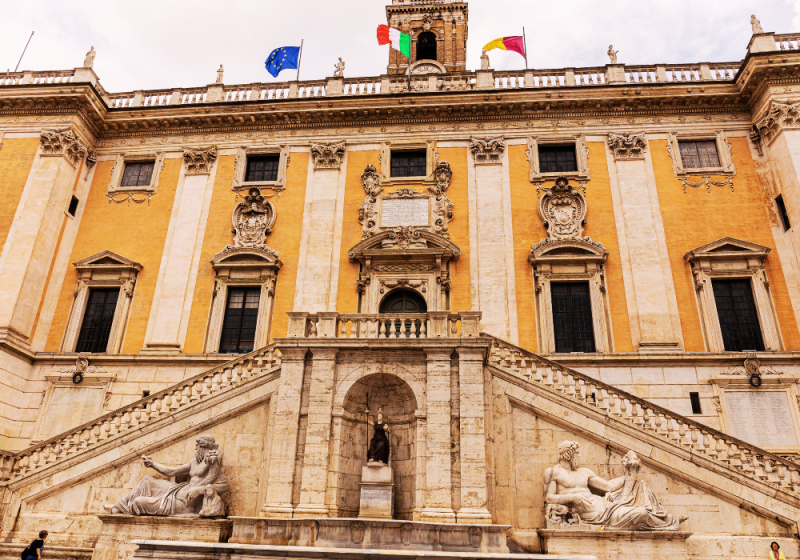
The Capitoline Museums are among the oldest public museums in the world. Located on Capitoline Hill, they house works by Caravaggio and Bernini. The museum also houses the famous statue of Romulus and Remus with the She-Wolf. Entry is free on the first Sunday of the month.
The piazza outside offers a beautiful view of the city. Take some time to explore the surroundings, including the statues and fountains.
Inspect the Museums of the Vatican City
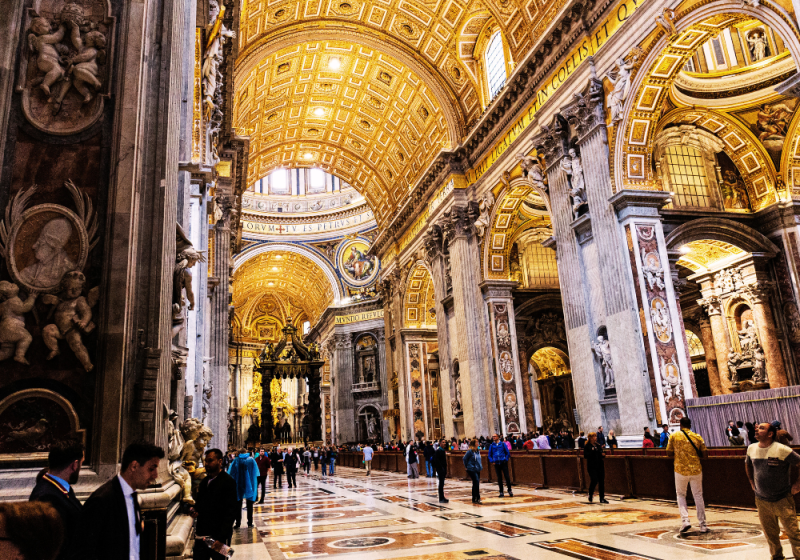
The Vatican Museums are famous for their stunning art collections and historical relevance. You can visit for free on the last Sunday of each month. Highlights include the Raphael Rooms and the Gallery of Maps. The Sistine Chapel, with Michelangelo’s ceiling, is a must-see.
Arrive early to avoid long lines. The free entry can attract large crowds, so plan accordingly.
Tour the National Roman Museum
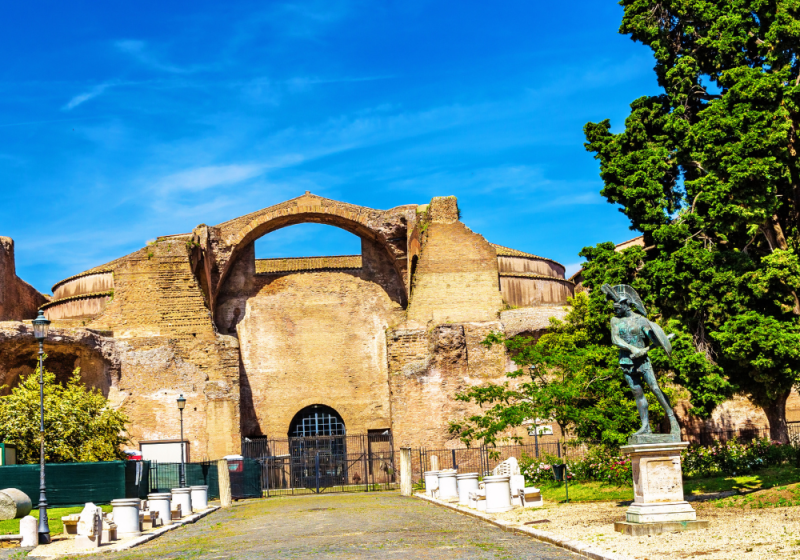
The National Roman Museum has multiple locations, including Palazzo Massimo and the Baths of Diocletian. Entry is free on the first Sunday of each month. This museum focuses on the ancient history of Rome and showcases sculptures, mosaics, and everyday items from Roman life.
Don’t miss the ancient frescoes and intricate mosaic floors. The Garden of the Palazzo Massimo is a nice spot for a rest. For a complete experience, remember to visit the other sites under the National Roman Museum.
Ancient Roads and Ruins
Exploring Rome’s ancient roads and ruins allows you to walk through history. Here are some of the most noteworthy sites where you can experience the grandeur of ancient Rome.
Walk Along the Appia Antica
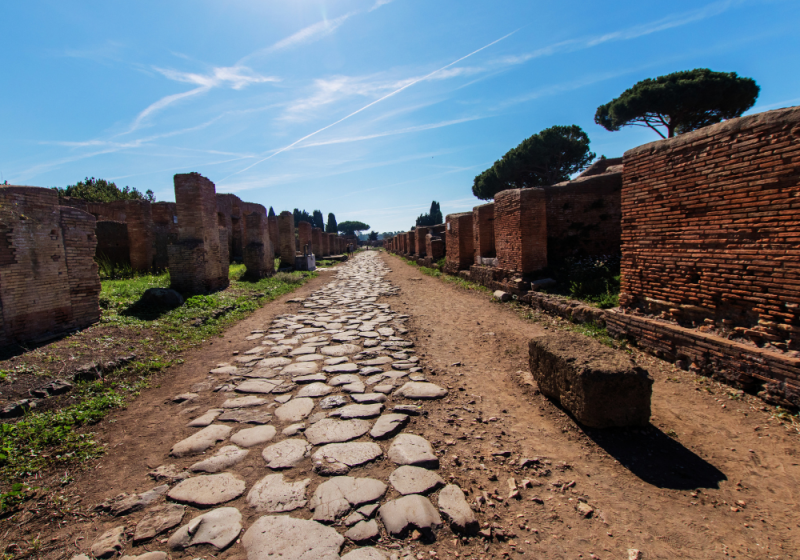
The Appia Antica, or the Appian Way, is one of the earliest Roman roads, originally built in 312 BC. This ancient path stretches from Rome to Brindisi, showcasing historical landmarks and lush countryside. Walking along the Appia Antica, you’ll see the Catacombs of San Callisto and San Sebastiano, two of the most famous Christian catacombs.
You’ll also encounter ruins of Roman villas and tombs like the Tomb of Cecilia Metella. This route offers history enthusiasts a unique perspective on Roman engineering and daily life. Bring comfortable walking shoes and a bottle of water, as the walk can be long but rewarding.
Examine the Circus Maximus
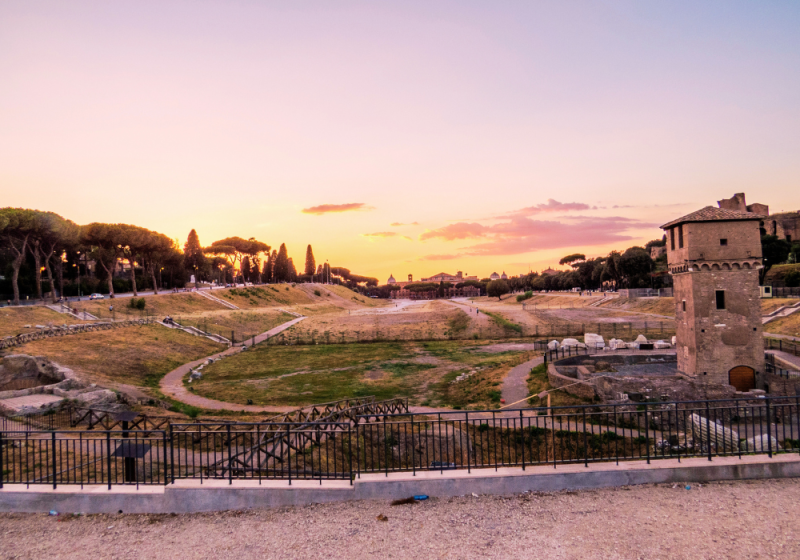
The Circus Maximus, or Circo Massimo, is an ancient Roman chariot racing stadium. It could hold up to 150,000 spectators, making it one of the largest. While only the outline remains today, the site still offers a glimpse into ancient Roman entertainment. You can enjoy a picnic here or just relax and imagine the races that once took place.
The nearby Palatine Hill offers additional historical ruins and views of the stadium. The Museum of the Ara Pacis is also close by and worth a visit for more Roman history. The wide, open space of the Circus Maximus is perfect for a stroll or some exercise.
Visit the Mouth of Truth
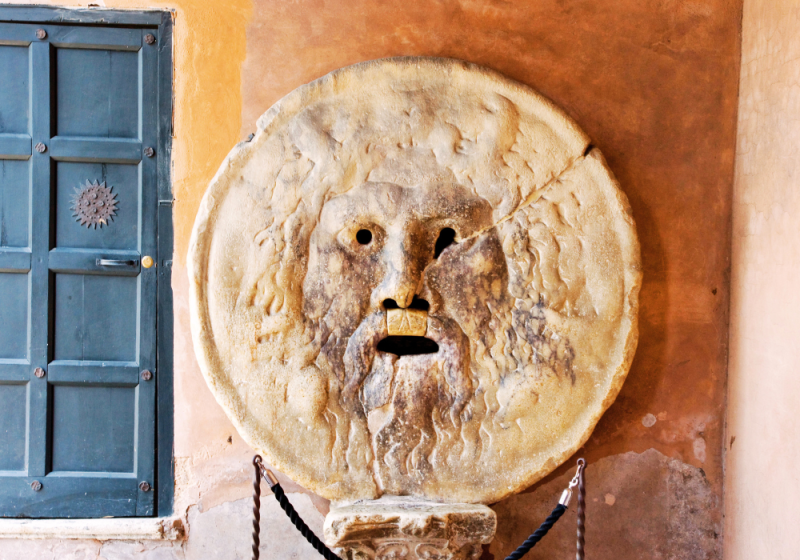
The Mouth of Truth (Bocca della Verità) is a large marble mask located in the portico of the church of Santa Maria in Cosmedin. According to legend, placing your hand in its mouth and telling a lie would result in your hand being bitten off. This makes for a fun and slightly eerie experience.
While you’re there, don’t miss the church itself, which dates back to the 6th century. Close by, you can also visit the Temple of Hercules and Temple of Portunus, some of Rome’s best-preserved ancient temples. Visiting this site is a blend of myth and history that adds a mysterious layer to your Roman adventure.
Vistas and Panoramic Points
Rome offers stunning viewpoints that allow you to experience the city’s beauty from above. Here are some of the best places to take in the remarkable scenery of Rome.
View from Pincio Terrace
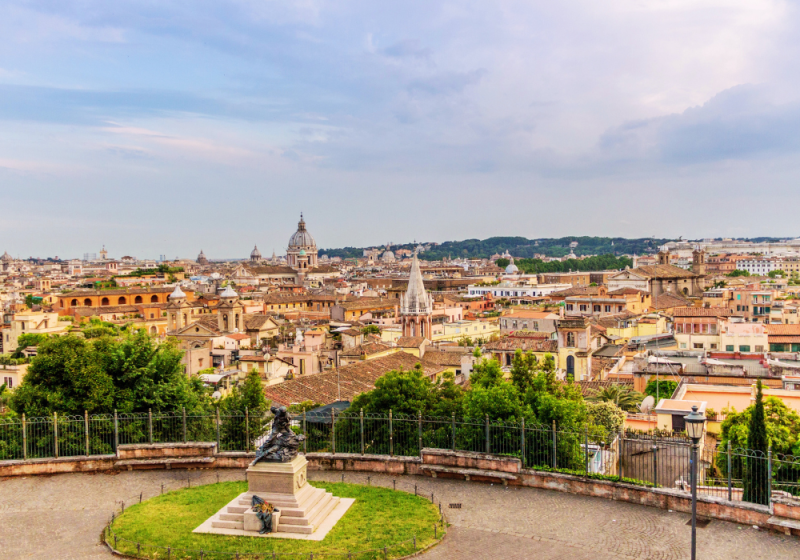
Pincio Terrace is located in the famous Borghese Gardens. It offers a panoramic view of Rome’s skyline, including St. Peter’s Basilica. The terrace is a great spot for a leisurely walk or a peaceful place to sit and enjoy the view.
The sky glows with warm colors during sunset, making it a popular time to visit. The terrace is less crowded in the morning, providing a more serene experience. Bring a camera to capture the stunning vistas and picturesque moments.
Look out from the Vittoriano
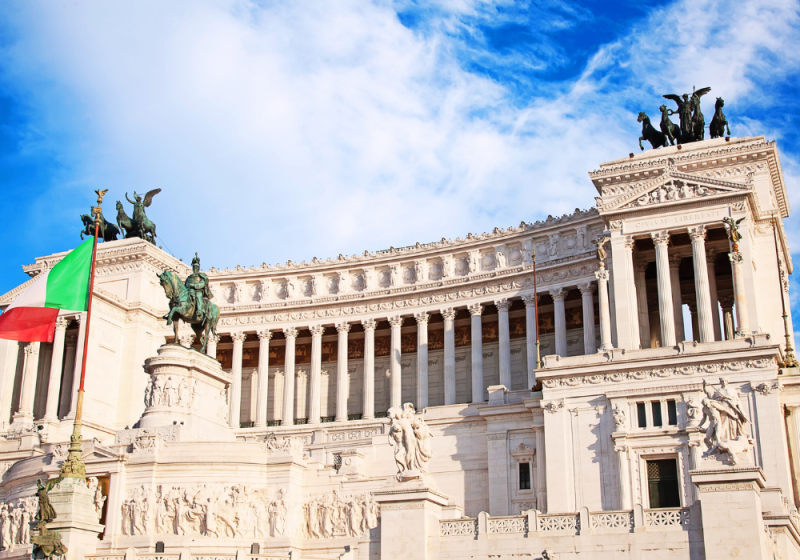
The Vittoriano, also known as the Altare della Patria, is one of Rome’s grand landmarks. It offers a 360-degree view of the city. Take a glass elevator to the top for a breathtaking view of the Roman Forum, the Colosseum, and other iconic attractions.
The monument itself is a marvel of architecture. Visiting the Vittoriano allows you to appreciate its historical significance and scenic beauty. Be sure to check out the museum inside for additional context about this impressive structure.
Enjoy the View of the Tiber River
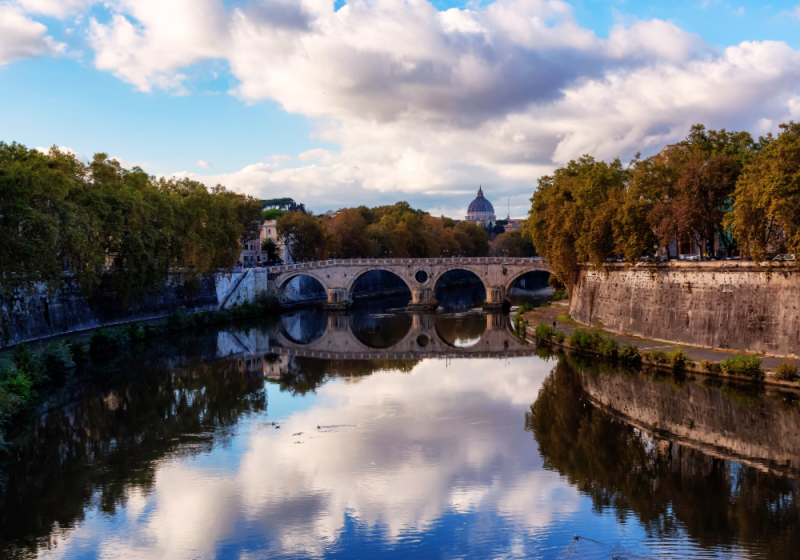
The Tiber River winds through Rome, providing beautiful views along its banks. One of the best spots to enjoy this view is from the Ponte Umberto I bridge. You can see St. Peter’s Basilica and the Sant’Angelo Bridge from here.
Walking along the river, especially near dusk, offers a peaceful escape from the bustling city streets. You’ll find charming cafes and restaurants along the way, perfect for a break while soaking in the views. The gentle flow of the river and the surrounding architecture create a captivating scene.
Frequently Asked Questions (FAQs)
Spellbinding read that keeps you wanting more: Fun Things to Do in Tokyo, Free Things to Do in Berlin, Free Things to Do in Amsterdam

